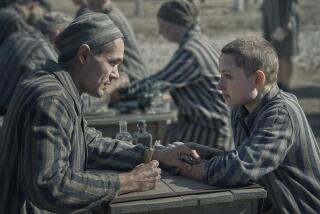BOOK REVIEW : ‘Asher Lev’ Sequel Revives Hero, a Hasid and Artist, 20 Years Later : THE GIFT OF ASHER LEV, <i> by Chaim Potok</i> . Knopf. $19.95, 369 pages
- Share via
Slightly off to the side of the more musical Modernism of American-Jewish authors Saul Bellow, Bernard Malamud and Phillip Roth, lies the oeuvre of Chaim Potok. It is an oeuvre that totals seven works of fiction, and if its author has never received quite the critical attention showered upon his more glamorous literary peers, he has known the compensatory pleasures of having claimed a unique subject matter and of cultivating a huge and highly loyal following.
The popular success of Potok’s books is not hard to understand. His novels are invariably well-crafted, composed with a feeling for the weights and measures of narrative, and boast a DeMilleian flair for monumental themes. The style, though occasionally cumbersome, has at least the virtue of directness and clarity. In addition, his books are always carefully researched and invariably impart a wealth of learning on his chosen subject.
That subject is more often a variation on the conflict between an Orthodox Jewish upbringing and the pagan, sensual pleasures brought to bear by the secular world. Though the cast and settings vary continuously, the central struggle of the books remains that of faith under siege by appetite and desire, of religious devotion at odds with the deracinating allure of American life.
In his latest novel, “The Gift of Asher Lev,” Potok sheds light on the shuttered world of the Hasidim--those bearded and hatted figures seen striding down the streets of New York and certain European cities. The Hasidim are historical fossils of a sort, flash-frozen remnants of a wave of 18th-Century Eastern European reaction to Enlightenment Orthodoxy and rationalism, who substituted a riddling, sensual reading of Scripture for the more formal “scientific” interpretation of their co-religionists. Defiant in their fundamentalism, they come down to the Modern Age best understood as ecstasy-specialists of a sort, the whirling dervishes of Judaism.
Asher Lev is a Hasid, but with a difference. He has become a painter of international stature. In the original best-selling novel, “My Name is Asher Lev,” published in 1972, Potok described the precocious awakening of Lev’s talent and defined the terms of what would turn out to be his lifelong battle with his father--a devout man who looked with cold fury upon his only son’s growing passion for profane images.
Luckily for Lev, his father’s opposition to his art was eventually overruled by the supreme spiritual leader of the community, the Rebbe--a mystical personage, equal parts Zeus and Kissinger--who was convinced that it was of the utmost importance that the boy follow the promptings of his temperament, even if they brought him within sinning distance of the sitra acha, the Other Side. The book concluded on the mixed, bittersweet note of a young man tasting his first creative success at the cost of exile from home and community.
“The Gift of Asher Lev” picks up 20 years later. In the interim, Lev has lived happily and, it is assumed, productively in France.
The plot-thickening additive of the novel arrives with the death of his beloved Uncle Yitzchok, a Brooklyn, N.Y., Hasid. Yitzchok, a jovial family man, was alone in encouraging the fledgling artists.
Full of trepidation at what he is going back to encounter, Lev returns to America with his family, to attend the funeral. For those who have read the first novel, the life into which he plunges is familiar in its warmth, its tensely pitched emotion, its prayerful silences.
The cast of characters has remained pretty much the same: the stern old-world father, now, whose life is defined by his religious rituals and globe-trotting service for the Hasidic community (he works as a kind of roving ambassador for the Rebbe); the gentle, put-upon mother, the warm gaggle of aunts and uncles and cousins.
The narrative begins to gather momentum when Lev discovers that Uncle Yitzchok has been inspired by Lev to collect art. For a Hasidic Jew this is strange enough, but when Lev discovers that his uncle has amassed a first-rate collection of Impressionist and Modernist masters, he is stunned.
A letter from Yitzchok is found, thanking Asher for having awakened his interest in art and entrusting him with the entire multimillion-dollar collection--a generosity that does not endear Lev to his uncle’s sons.
Having thus framed the opening scenes, the book settles down to its main business, which is propelling its protagonist through a series of carefully drawn tableaux of the Hasidic world of Brooklyn, the international world of art, and the calmer, airier world of France--specifically Paris, and the south of France, where Lev has a country house.
The book has a Balzackian density of characterization and event, of minor figures who step momentarily onto the stage of the novel, perform their necessary narrative service and then depart.
The Rebbe shadows Lev, entreating him to stay on in America, asking constantly after his family, and taking a particular interest in the future of his young son Avrumel. This sudden attention lavished upon a former outcast by a figure as forbidding and remote as the Rebbe is flattering, but also puzzling and even worrisome. It remains so until the very end of the book, when the cause of the Rebbe’s interest is finally made clear--when triumphantly, the nature of Asher Lev’s “gift” is revealed.
Despite the complexity of its protagonist, the book suffers by comparison with its predecessor. Whereas “My Name Is Asher Lev” was carried along by that naive power of discovery that is one of Potok’s gifts--that feeling about his books of slightly raw-boned revelation--the proper word for the sequel is sedulous, as in diligent, or dully competent.
Potok’s old bugaboo--his somewhat leaden, overly iterative style--here seems more obvious and disappointing than ever and is responsible for long patches of ineffectual description. A faint aura of bathos drifts over the family dramas at some moments, a sense of unearned emotion that distracts the reader.
This is all the more distressing because Potok himself possesses what is clearly a first-rate mind. Even as one wishes he had somehow found the means to compress his language and sharpen the attack of his narrative, one cannot help but admire his erudition and endowment of intellect. Potok has created a book with occasional moments of great power, which will doubtless inspire the same fierce loyalty in readers as his other works. It must be added, however, that for those who remember the effortless sweep and scope of the original novel, there will be some disappointment.
More to Read
Sign up for our Book Club newsletter
Get the latest news, events and more from the Los Angeles Times Book Club, and help us get L.A. reading and talking.
You may occasionally receive promotional content from the Los Angeles Times.










